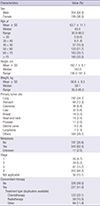1. Ventafridda V, Caraceni A, Gamba A. Field-testing of the WHO guidelines for cancer pain relief: summary report of demonstration projects. In : Foley KM, Bonica JJ, Ventafridda V, editors. Proceedings of the Second International Congress on Cancer Pain. Vol. 16. Advances in Pain Research and Therapy. New York, NY: Raven Press, Ltd.;1990. p. 451–464.
2. Schug SA, Zech D, Dörr U. Cancer pain management according to WHO analgesic guidelines. J Pain Symptom Manage. 1990; 5:27–32.
3. Portenoy RK, Lesage P. Management of cancer pain. Lancet. 1999; 353:1695–1700.
4. World Health Organization. Cancer Pain Relief. 2nd ed. Geneva: World Health Organization;1996.
5. Cherny NJ, Chang V, Frager G, Ingham JM, Tiseo PJ, Popp B, Portenoy RK, Foley KM. Opioid pharmacotherapy in the management of cancer pain: a survey of strategies used by pain physicians for the selection of analgesic drugs and routes of administration. Cancer. 1995; 76:1283–1293.
6. Chaplan SR, Duncan SR, Brodsky JB, Brose WG. Morphine and hydromorphone epidural analgesia. A prospective, randomized comparison. Anesthesiology. 1992; 77:1090–1094.
7. Goodarzi M. Comparison of epidural morphine, hydromorphone and fentanyl for postoperative pain control in children undergoing orthopaedic surgery. Paediatr Anaesth. 1999; 9:419–422.
8. Wallace M, Moulin DE, Rauck RL, Khanna S, Tudor IC, Skowronski R, Thipphawong J. Long-term safety, tolerability, and efficacy of OROS hydromorphone in patients with chronic pain. J Opioid Manag. 2009; 5:97–105.
9. Pigni A, Brunelli C, Caraceni A. The role of hydromorphone in cancer pain treatment: a systematic review. Palliat Med. 2011; 25:471–477.
10. Kumar MG, Lin S. Hydromorphone in the management of cancer-related pain: an update on routes of administration and dosage forms. J Pharm Pharm Sci. 2007; 10:504–518.
11. Bruera E, Sloan P, Mount B, Scott J, Suarez-Almazor M. A randomized, double-blind, double-dummy, crossover trial comparing the safety and efficacy of oral sustained-release hydromorphone with immediate-release hydromorphone in patients with cancer pain. Canadian Palliative Care Clinical Trials Group. J Clin Oncol. 1996; 14:1713–1717.
12. Ferrell B, Wisdom C, Wenzl C, Brown J. Effects of controlled-released morphine on quality of life for cancer pain. Oncol Nurs Forum. 1989; 16:521–526.
13. Palangio M, Northfelt DW, Portenoy RK, Brookoff D, Doyle RT Jr, Dornseif BE, Damask MC. Dose conversion and titration with a novel, once-daily, OROS osmotic technology, extended-release hydromorphone formulation in the treatment of chronic malignant or nonmalignant pain. J Pain Symptom Manage. 2002; 23:355–368.
14. Drover DR, Angst MS, Valle M, Ramaswamy B, Naidu S, Stanski DR, Verotta D. Input characteristics and bioavailability after administration of immediate and a new extended-release formulation of hydromorphone in healthy volunteers. Anesthesiology. 2002; 97:827–836.
15. Angst MS, Drover DR, Lötsch J, Ramaswamy B, Naidu S, Wada DR, Stanski DR. Pharmacodynamics of orally administered sustained- release hydromorphone in humans. Anesthesiology. 2001; 94:63–73.
16. Verma RK, Krishna DM, Garg S. Formulation aspects in the development of osmotically controlled oral drug delivery systems. J Control Release. 2002; 79:7–27.
17. Bass DM, Prevo M, Waxman DS. Gastrointestinal safety of an extended-release, nondeformable, oral dosage form (OROS®): a retrospective study. Drug Saf. 2002; 25:1021–1033.
18. Turgeon J, Gröning R, Sathyan G, Thipphawong J, Richarz U. The pharmacokinetics of a long-acting OROS hydromorphone formulation. Expert Opin Drug Deliv. 2010; 7:137–144.
19. Wallace M, Rauck RL, Moulin D, Thipphawong J, Khanna S, Tudor IC. Once-daily OROS hydromorphone for the management of chronic nonmalignant pain: a dose-conversion and titration study. Int J Clin Pract. 2007; 61:1671–1676.
20. Goforth HW. Hydromorphone-OROS formulation. Expert Opin Pharmacother. 2010; 11:1207–1214.
21. Shin SH, Lee HS, Kim YS, Choi YJ, Kim SH, Kwon HC, Oh SY, Kang JH, Sohn CH, Lee SM, et al. Clinical usefulness of hydromorphone-OROS in improving sleep disturbances in Korean cancer patients: a multicenter, prospective, open-label study. Cancer Res Treat. 2014; 46:331–338.
22. Guay DR. Oral hydromorphone extended-release. Consult Pharm. 2010; 25:816–828.
23. Hanna M, Thipphawong J. 118 Study Group. A randomized, double-blind comparison of OROS(R) hydromorphone and controlled-release morphine for the control of chronic cancer pain. BMC Palliat Care. 2008; 7:17.
24. Hanna M, Tuca A, Thipphawong J. An open-label, 1-year extension study of the long-term safety and efficacy of once-daily OROS(R) hydromorphone in patients with chronic cancer pain. BMC Palliat Care. 2009; 8:14.
25. Gardner-Nix J, Mercadante S. The role of OROS hydromorphone in the management of cancer pain. Pain Pract. 2010; 10:72–77.
26. Han HS, Lee KH, Lee KH, Ryu JS, Kim YC, Park SW, Oh HS, Park KT, Kwon JH, Lee PB, et al. A prospective, open-label, multicenter study of the clinical efficacy of extended-release hydromorphone in treating cancer pain inadequately controlled by other analgesics. Support Care Cancer. 2014; 22:741–750.
27. Song EK, Shim H, Han HS, Sun D, Lee SI, Kang MH, Lee K, Cho D, Cho IS, Park SY, et al. A prospective multicentre study to evaluate the efficacy and tolerability of osmotic release oral system (OROS) hydromorphone in opioid-naive cancer patients: results of the Korean South West Oncology Group study. Pain Res Manag. 2015; 20:293–299.
28. Jonsson T, Christrup LL, Højsted J, Villesen HH, Albjerg TH, Ravn-Nielsen LV, Sjøgren P. Symptoms and side effects in chronic non-cancer pain: patient report vs. systematic assessment. Acta Anaesthesiol Scand. 2011; 55:69–74.











 PDF
PDF ePub
ePub Citation
Citation Print
Print



 XML Download
XML Download